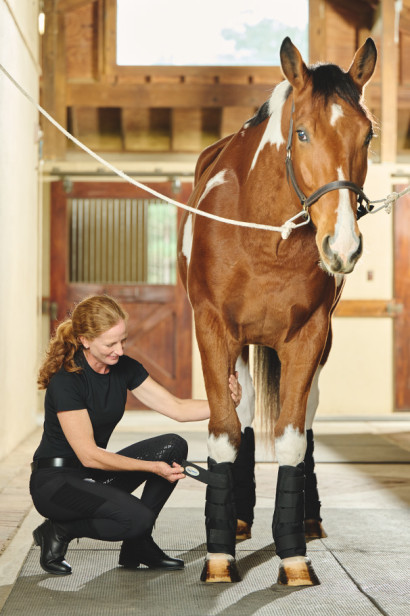Discover the Incredible Advantages of Equine Therapy for Psychological Recovery
Discover the Incredible Advantages of Equine Therapy for Psychological Recovery
Blog Article
Evaluating the Efficiency of Laser Therapy in Equine Therapy for Injury Rehabilitation
The evaluation of laser therapy's performance in equine injury rehabilitation depends upon multiple aspects, consisting of healing time, discomfort reduction, and tissue regrowth. Professional studies recommend noteworthy improvements in conditions like tendonitis and osteoarthritis, associated to boosted cellular function and elevated ATP manufacturing. Vets frequently observe exceptional results with laser treatment contrasted to standard methods, placing it as a crucial component in equine care. The need for continuous monitoring and personalized therapy strategies can not be overemphasized. What specific clinical evidence supports these claims, and exactly how do vets apply these methods in practice?
Comprehending Laser Therapy
Laser therapy has come to be a crucial device in vet medication, especially in the treatment of equine conditions. Known for its non-invasive nature and efficiency, laser treatment includes the application of particular wavelengths of light to stimulate tissue fixing and lower swelling. This restorative modality is increasingly favored for its capacity to speed up the healing process in horses dealing with a variety of bone and joint injuries and chronic conditions.
The main mechanism behind laser treatment is its ability to boost cellular features. When laser light penetrates the skin, it is absorbed by mitochondria, the powerhouse of cells, which causes raised production of adenosine triphosphate (ATP) This biochemical energy increase assists in mobile repair work and regrowth. In addition, laser treatment promotes vasodilation, enhancing blood flow and oxygen shipment to damaged tissues, thus expediting recuperation.
In equine medicine, laser treatment is specifically beneficial for conditions such as tendonitis, osteoarthritis, and injury recovery. The technique is lauded for its pain-relieving properties, allowing equines to gain back flexibility and feature extra rapidly. Veterinarians also appreciate its minimal side impacts compared to other treatment techniques, making it a trusted and secure alternative for equine treatment.

How Laser Therapy Functions

Upon absorption, these photons set off a series of biochemical adjustments, improving mitochondrial function and leading to raised adenosine triphosphate (ATP) manufacturing. This rise in ATP increases mobile metabolism, advertising cells repair work and regrowth. Furthermore, laser therapy modulates inflammatory actions by impacting cytokine levels and minimizing oxidative tension, thereby relieving discomfort and swelling.
Another substantial element of laser treatment is its function in enhancing microcirculation. The treatment promotes vasodilation, boosting blood flow and oxygen distribution to damaged cells (Equine Therapy). This helps with the elimination of cellular particles and supports the spreading of fibroblasts and collagen synthesis, important for injury healing
Professional Evidence
The efficacy of laser treatment in equine treatment has been confirmed with numerous medical researches, showcasing its restorative possible across a variety of problems. Several regulated trials and observational researches have documented substantial improvements in cells repair, pain decrease, and overall rehab timelines. A research carried out by Turner et al. (2012) showed that horses treated with low-level laser therapy (LLLT) for ligament injuries showed accelerated healing compared to those obtaining standard treatments. The study highlighted a marked decrease in swelling and boosted collagen development.
Similarly, research by Johnson and colleagues (2015) concentrated on equine muscular tissue injuries, disclosing that laser treatment dramatically quickened muscular tissue fiber regrowth and decreased muscle stiffness. These searchings for look here were corroborated by histological evaluations revealing enhanced muscle cells company. Professional evaluations have revealed that laser treatment can reduce chronic problems such as osteoarthritis. A study by Smith et al. (2018) reported that steeds with osteoarthritic joints experienced noteworthy pain alleviation and enhanced series of movement following a routine of laser therapy sessions.
Veterinarian Insights

Veterinarians also appreciate the convenience of laser treatment. She directs out that laser therapy can be tailored to the details demands of each equine, making sure ideal outcomes.
Moreover, vets value the capability to integrate laser treatment with various other treatment modalities. This multimodal strategy can improve overall therapy effectiveness, offering an extensive remedy for equine recovery. Such endorsements from seasoned specialists highlight the growing approval and application of laser therapy in equine medication.
Practical Factors To Consider
An essential facet of applying laser therapy in equine therapy includes understanding the sensible considerations that guarantee its efficiency and security. It is important to pick the suitable laser device, as different types differ in wavelength, power, and infiltration depth. Veterinarians have to be well-versed in these parameters to customize therapy protocols efficiently to every injury kind
In addition, the frequency and duration of laser treatment sessions require mindful planning to make the most of restorative advantages while lessening any kind of potential negative results. next page Consistent tracking of the steed's response to treatment can assist essential adjustments in the therapy program. Developing a secure and controlled environment during therapies is additionally important to stop unintended direct exposure to laser emissions, which could hurt both the equine and the trainer.
Educating and qualification of personnel administering laser therapy are critical to make sure correct strategy and to promote safety standards. Additionally, maintaining accurate records of each session, including laser setups and observed end results, is vital for evaluating the overall effectiveness of the treatment and for making data-driven decisions.
Conclusion
Laser therapy has actually emerged as a reliable technique in equine injury rehabilitation, offering significant benefits in helpful resources recovery time, discomfort relief, and cells healing. For optimal outcomes, constant monitoring and personalized treatment methods remain essential in leveraging the complete potential of laser treatment in equine care.
Report this page